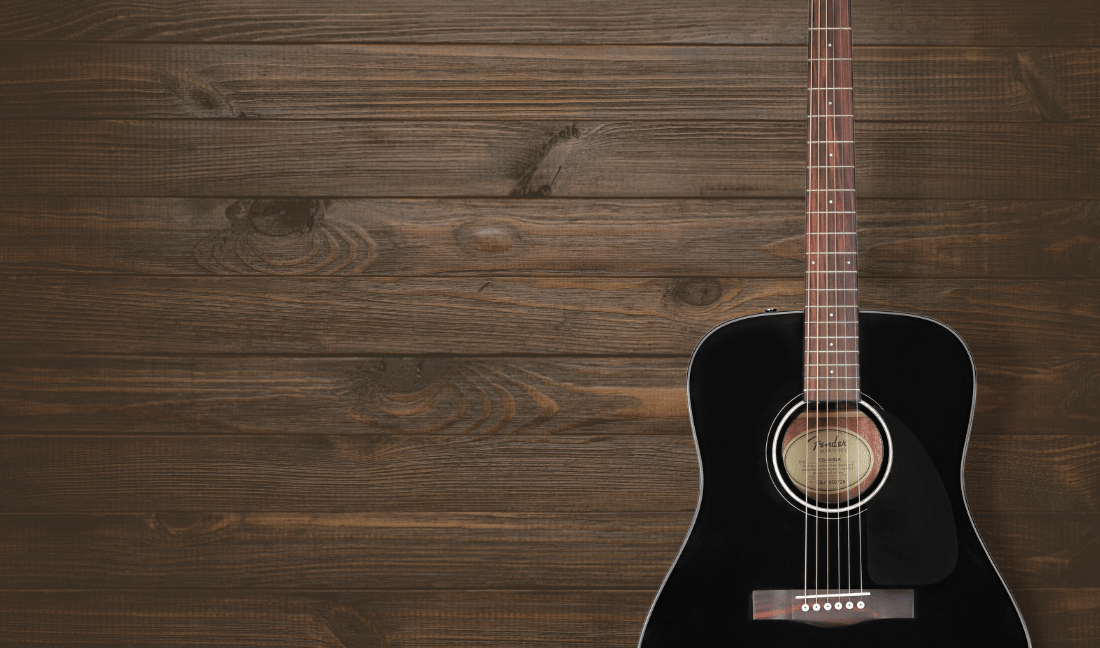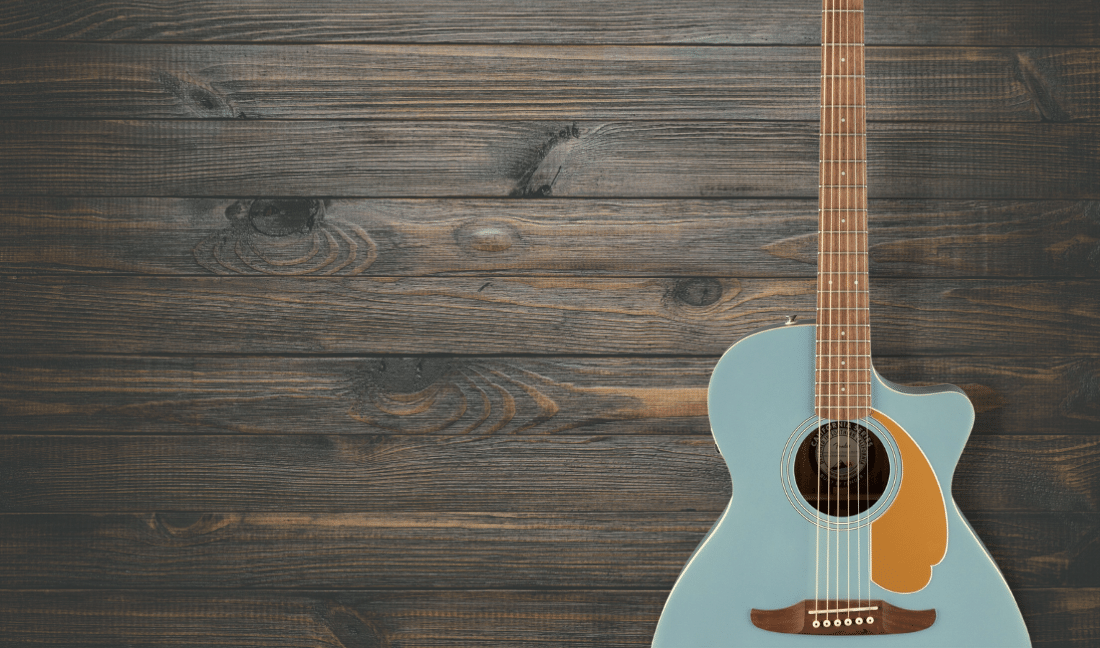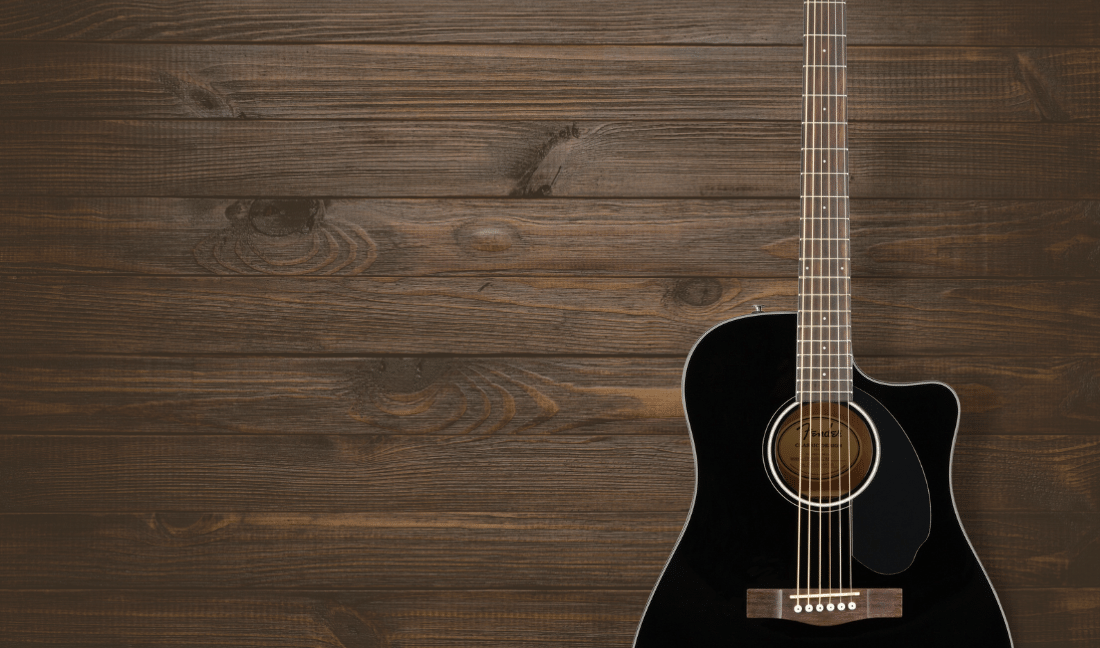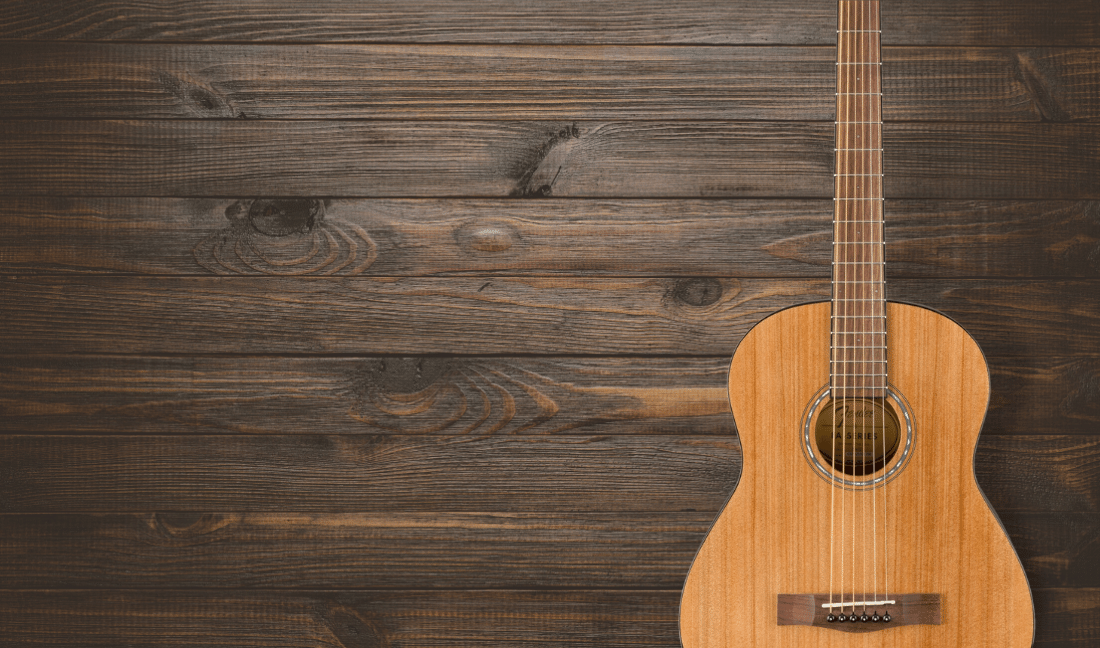If you are looking for a simple acoustic guitar that still offers quality construction and sound, the Fender CD-60 is a great option.
It features a non-cutaway body with gloss polyurethane finish, a top made of laminated spruce, back and sides made of laminated mahogany, and a 25.3″ (643 mm) scale length.
You can purchase this guitar in many different stores, some of them include:
We may earn commissions from these links at no additional cost to you.
In this post, we’ll take a close look at the Fender CD-60 acoustic guitar, specifically its features, tone, value, and playability.
Certain guitar features can alter the overall feel and value of the instrument, thus it is critical to choose them carefully.
Table of Contents
Summary
Here’s a very quick summary of the Fender CD-60’s performance.
Keep in mind that the score and rating we give each point is just our opinion and is totally subjective to each person.
Hardware
A guitar’s hardware refers to the various metal and plastic parts that make up the instrument.
These include but are not limited to:
- Tuning machines
- Pickguard
- Bridge
- Strings
- Strap buttons
- Pickups
- Tailpiece
- Control knobs
Fender’s acoustic guitars are well-known for their solid and long-lasting construction.
The company has generally always used high-quality materials for its products, which is evident in many of the different successful models that they’ve built throughout the years.
When buying a guitar primarily based on its hardware, ensure that it is of high quality and that it appears to be strong enough to withstand regular use.
Plastic saddles on the bridge, for example, are common on lower-quality guitars, which can have a detrimental impact on the instrument’s tone and intonation, as well as making it more difficult to tune.
Also, check sure that the metal pieces themselves are not prone to rusting or tarnishing, and that they appear to be strong, durable, and not easily damaged.
A decent-sounding and playable guitar requires excellent hardware, and there are a few things that a manufacturer can do to make it perfect for us guitarists.
Let’s take a look at it more closely!
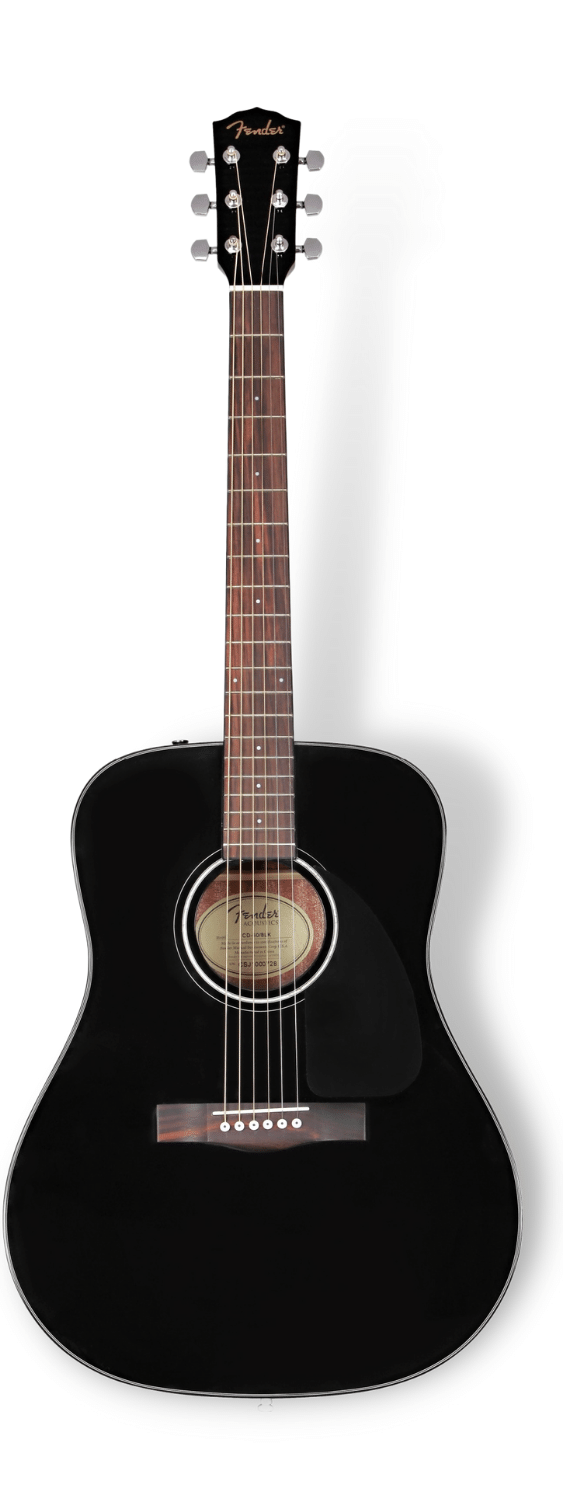
– Tuning Machines
On this Fender CD-60, the tuning machines are die-cast, made of chrome, and have a closed-back geared design.
- Type: Die-Cast
- Design: Closed-Back Geared
Tuning machines (generally referred to as “tuners”) are an essential aspect of every guitar’s hardware.
They’re in charge of keeping the strings tight and firm so they can vibrate properly and produce the right pitch.
Low-quality tuning machines can ruin the sound of even the best guitar, so choose wisely.
This is due to the fact that tuning machines are what keep the guitar’s strings tight.
If your tuning machines are not working as they should, the strings will become loose and go out of tune.
They can also make changing strings more difficult, as well as make the guitar harder to play in general.
Must Remember:
High-quality tuning machines are usually constructed from tougher materials and have dependable, smooth action.
Make sure to avoid materials like nickel-plated steel or stainless steel to prevent rust.
Because these materials don’t tarnish, your instrument will last much longer.
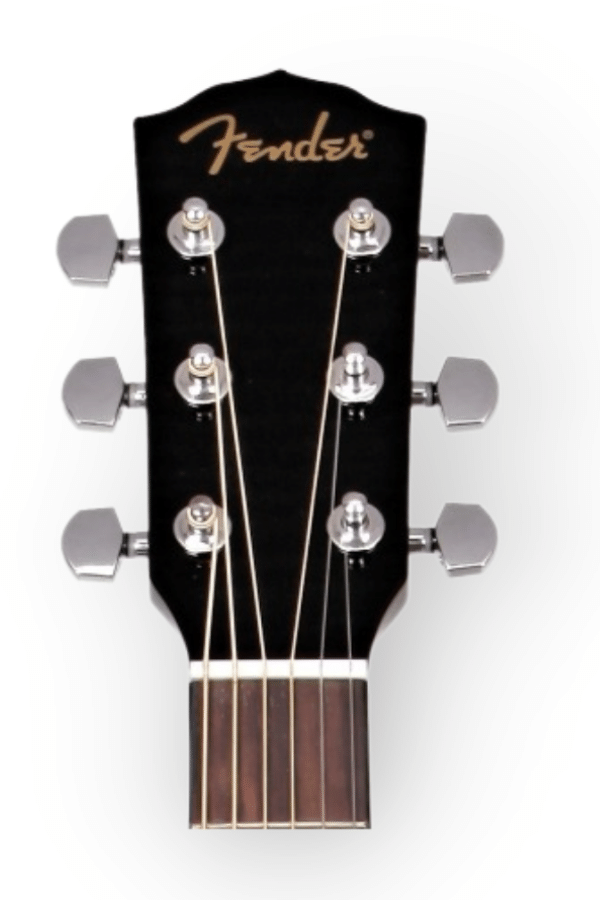
– Pickguard
The Fender CD-60 comes with a black pickguard that has a 1-ply plain design.
- Color: Black
- Design: 1-Ply Plain
Having fewer layers means that scratches and wear will usually be more visible on the pickguard over time.
Pickguards are often made of plastic, in some cases, even carbon fiber, and come in a variety of styles.
Their aim is to protect the guitar’s finish against scratches caused by the pick as you play.
A decent pickguard should be built of a strong material that can survive repeated use.
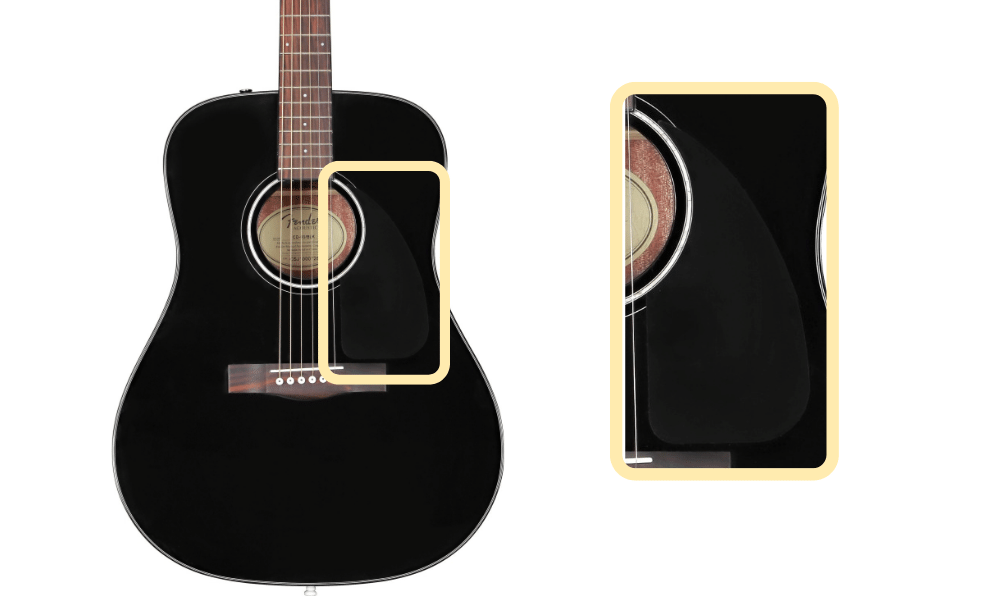
It also should be in a position where it’s likely to actually protect the body of the guitar from scratches caused by the player’s pick.
In terms of appearance, a pickguard should also match the guitar’s overall design.
It shouldn’t be too noticeable, but it also shouldn’t be too small or low-quality that it seems out of place.
– Strap Buttons
Both strap buttons on the Fender CD-60 are constructed of chrome, appear to be strong enough, and are found at the bottom and side of heel of the guitar.
Strap buttons are those little metal buttons installed on the guitar’s body that are used to secure a strap to the instrument.
One on either side of the body, most guitars will generally feature two strap buttons.
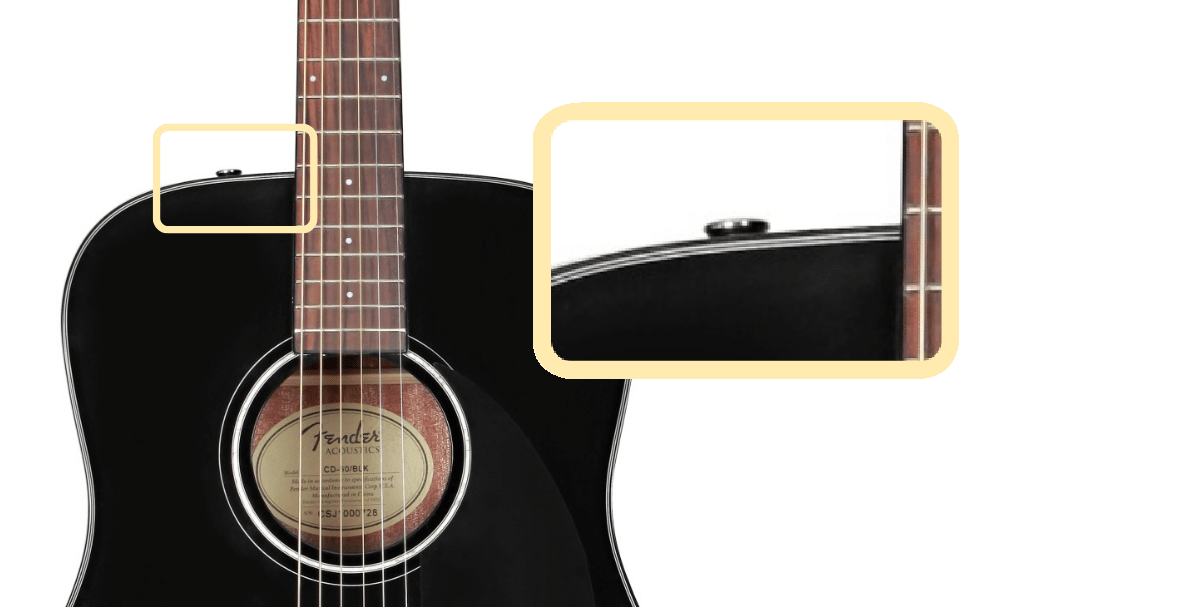
Metal strap buttons should be durable and strong so they don’t come free over time.
Even though for most people, whether the strap buttons are good or not won’t be a deal-breaker for them, it’s still something to keep in mind when reviewing a guitar.
Body
The body of a guitar is the main part of the instrument, and it’s where the neck, bridge, and strings are attached.
A hole (the “soundhole”) through which sound can resonate from within the instrument can also be found here.
The majority of guitars have a wooden body, while others have carbon fiber, metal, or plastic bodies (less usual).
– Wood
If you have a specific tone in mind for your guitar, you should take into account the type of wood used for the body.
The Fender CD-60 features a laminated spruce top with a laminated mahogany back and laminated mahogany sides.
Having a solid top is important because it means that the wood hasn’t been laminated, which could affect the sound quality since laminated wood is often thinner.
When wood is laminated, this means that strips of wood are glued together to create a piece.
– Finish
The guitar’s body finish is the last layer of protection for the wood.
When it comes to this guitar in specific, it has a gloss polyurethane finish.
It’s what gives the guitar its brilliance and shine, but also protects the wood from scratches, dents, and other damages.
There are many types of finishes that you’ll come across, some of them are:
- Polyurethane
- Nitrocellulose Lacquer
- Polyester
Nitrocellulose Lacquer is considered to be the best type of finish, but it’s also the most expensive.
It’s a durable finish that can be buffed to a high shine, and it’s also relatively easy to repair if it’s damaged.
Polyurethane is a cheaper alternative that’s almost as good, and Polyester is the cheapest option but it doesn’t provide as much protection.
Among these categories, there are subcategories as well, such as:
- Gloss finishes: High shine and they’re very reflective.
- Matte finishes: Have a lower shine and they’re not very reflective.
- Satin finishes: Somewhere in-between gloss and matte, they have a moderate shine and they’re somewhat reflective.
– Colors Available
When it comes to the body of a guitar, the color is usually not a big factor in the overall sound.
Yet, it can affect the instrument’s appearance and feel.
Some people prefer a guitar that’s a certain color because it matches their style, or because it’s easier to see in low light conditions.
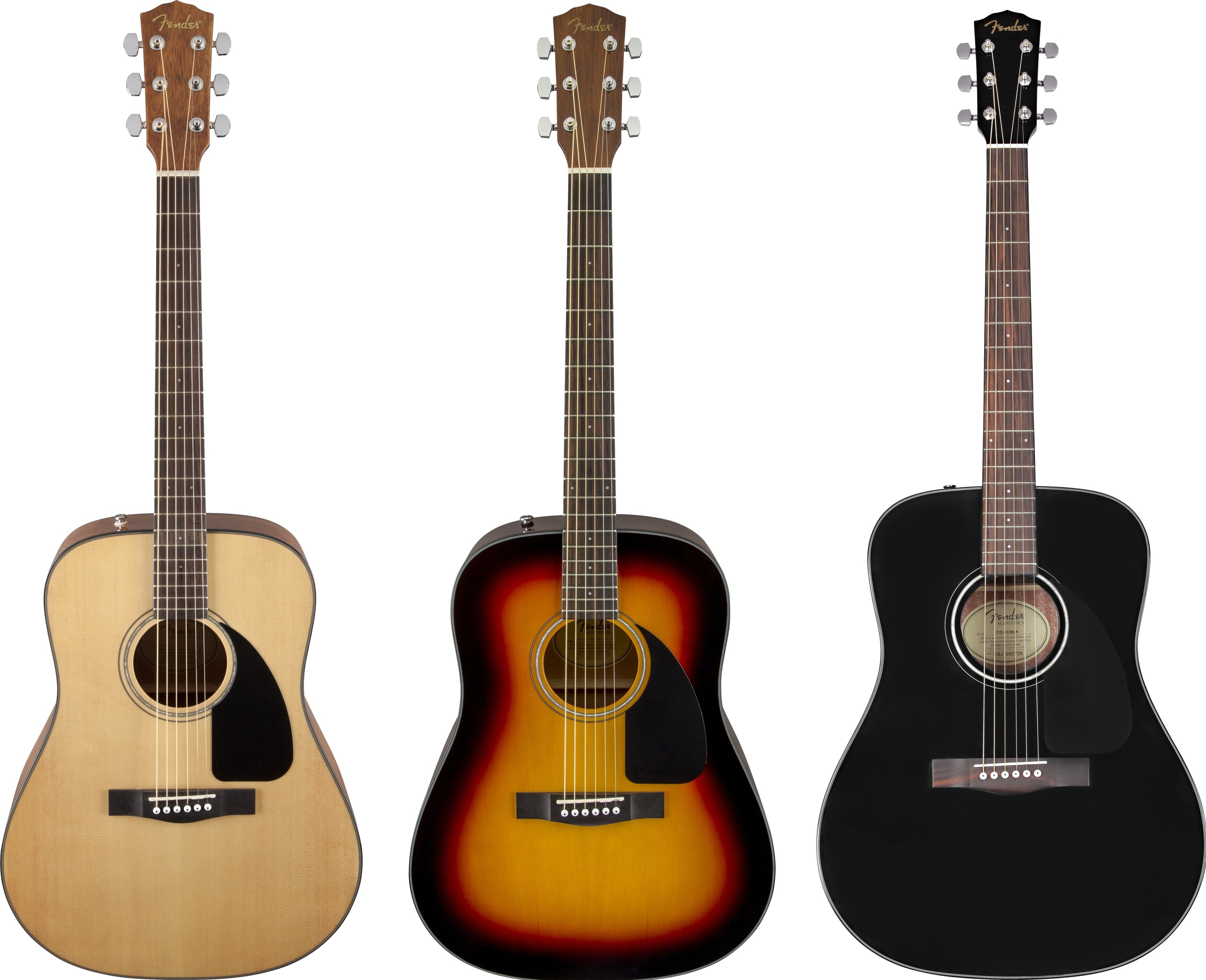
Some of the most popular colors for guitar bodies are:
- Natural: This is the color of wood that hasn’t been stained or painted.
- Black: Black is a popular color for metal-style guitars.
- Sunburst: Sunburst is a combination of light and dark colors, usually red, yellow, and brown.
Choosing a guitar based on its color is purely a matter of personal preference.
But if you do take your time and choose something that you’re happy with, you’ll be much more likely to play it often and develop your skills quicker.
– Bridge, Saddle, and Pins
The Fender CD-60 has walnut bridge with white with black dots pins and also a saddle made of crème plastic.
Each of these elements has a significant impact on how the guitar sounds and feels.
For example, the bridge is responsible for transferring string vibrations to the guitar’s body.
The saddle, which is often composed of plastic or bone, is where the strings rest.
And the pins are what keep the strings in place so that you can play your instrument.

There are many various types of bridges, each with their own set of advantages and disadvantages.
On acoustic guitars, you’ll mainly see three types of bridges:
- Pin bridges (standard)
- Pinless bridges
- Classical bridge
Pin bridges are the most prominent type of bridge and the simplest to rebuild and replace.
However, they can be a bit more difficult to intonate, which means getting the strings in the correct position.
Pinless bridges are bit less common, although they are easy to intonate as well.
They also have the advantage of not requiring any pins, which can be a pain to keep track of.
Finally, classical guitar bridges are only found for the most part on classical guitars.
They are similar in design to most other bridges, but the key distinction is that they have no pins and instead consist of a saddle and a wooden block with a hole for each string.
Said hole is used to tie the string down, which gives the guitar a much cleaner look.
Now, the type of saddle you choose is also important; plastic saddles are the cheapest and easiest to find, but they don’t last as long as bone saddles.
The cost of bone saddles tend to be more, but they are also more durable than other options.
As for the bridge pins, there are three main types:
- Plastic bridge pins
- Steel bridge pins
- Brass bridge pins
Plastic bridge pins are the cheapest and easiest to find, but they are known to be the least durable.
Steel bridge pins are more expensive, but they’re also more durable in many ways.
Brass bridge pins are the most expensive, but they’re also the most durable our of the three.
Neck
When it comes to the Fender CD-60, its neck is made of mahogany with a gloss urethane finish, and it has a “C” Shape shape with an dual-action truss rod.
The neck is the long, thin component of the guitar that runs from the body to the headstock and is generally made of wood.
Since different woods have distinct qualities that influence how the vibrations created by the strings behave, the type of wood chosen for the neck can affect the guitar’s playability and sound.
The most popular style of neck is the bolt-on neck, which is screwed or fastened onto the body of the guitar.
Set-necks, which are glued to the body, are another popular style.
The fretboard, frets, nut, and truss rod are all crucial components of a guitar neck.
Fretboard
The fretboard is the surface on the neck of the guitar where your fingers push down on the strings.
It’s most commonly made of wood, although it can also be made of carbon fiber, plastic, or even metal.
As for the Fender CD-60, it has a fretboard made of walnut with a radius of 12″ (305 mm) and white pearloid dot inlays:

Despite the fact that this has long been a source of debate, it is generally accepted that the type of wood used for the fretboard might have a minor impact on the sound of the guitar.
For instance, maple is a popular material for electric guitars because it tends to produce a very sharp tone.
Rosewood is another popular material for acoustic guitars because it provides a warm and full-bodied tone.
Ebony is yet another popular choice, and it’s often used on guitars that are meant to have a really clean, clear sound.
There are several varieties of fretboards available, each with its own set of benefits and drawbacks.
The sort of fretboard you pick is ultimately up to you and what you’re looking for in a guitar; the tone will not change dramatically, but the feel will.

Brand Info
Fender is a leading manufacturer of electric guitars, and they’ve been in business since 1946.
They’re one of the most iconic guitar brands in the world, and their instruments are used by some of the most famous musicians of all time.
Also, the company offers a wide range of different models, from simple beginner guitars to complex professional instruments.
Their guitars are known for their great tone and quality craftsmanship, and they’re a popular choice for both beginner and experienced players.
At the same time, Fender guitars are very affordable, making them a great option for budget-conscious musicians.

Videos
For those of you who want to get a more in-depth look at this guitar, we’ve included some videos below.
The first video is a demo showing off how it sounds and looks.
While the second video is a review that goes over some of its features and specs.
Demo
Review
Specifications
A guitar’s specifications can tell you a lot about the instrument, and they can be helpful when you’re trying to decide between different models.
Below, we’ve included the specifications for the Fender CD-60:
– General
| Brand | Fender |
| Model | CD-60 |
| Type | Acoustic |
| Number of Strings | 6 |
| Hardware Plating | Chrome |
| Tuning Machines | Die-Cast |
| Tuning Machines Design | Closed-Back Geared |
| Electro-acoustic | No |
| Built-in Tuner | No |
| Colors | Black, Natural, Sunburst |
– Body
| Body Style | Dreadnought |
| Cutaway | No |
| Solid Top | No |
| Top Material | Laminated Spruce |
| Back Material | Laminated Mahogany |
| Sides Material | Laminated Mahogany |
| Finish Type | Gloss Polyurethane |
| Pickguard | Yes |
| Pickguard Color | Black |
| Pickguard Design | 1-Ply Plain |
| Strap Buttons | Yes |
| Strap Buttons Position | Bottom and side of heel |
| Strap Buttons Design | Classic |
– Neck
| Neck Material | Mahogany |
| Neck Shape | “C” Shape |
| Neck Finish | Gloss Urethane |
| Scale Length | 25.3″ (643 mm) |
| Truss Rod | Dual-Action |
– Fretboard
| Fretboard Material | Walnut |
| Fingerboard Inlay | White Pearloid Dot |
| Fret Size | 2mm |
| Number of Frets | 20 |
– Bridge, nut, saddle, pins
| Bridge Pins | White with Black Dots |
| Bridge | Walnut |
| Saddle Material | Crème Plastic |
| Nut Material | Crème Plastic |
| Nut Width | 1.69″ (43 mm) |
Please note that some brands might change the features and type of materials that they have and use on their guitars.
If you see a discrepancy in any of these specifications, please let us know and we’ll correct it.
I also encourage you to check out our other guitar reviews if you’re looking for something specific that you might have not found here with this guitar.
We have reviews on electric guitars, acoustic guitars, bass guitars, effects pedals, and more.
No matter what your budget is, or what type of guitar you’re looking for, we should be able to help you find the perfect one for you.

More than 10 years of experience playing and writing about guitars! When not writing, I can be found strumming away some Johnny Cash tunes. Favorite all time guitar is the Gibson Les Paul. #TeamGibson

